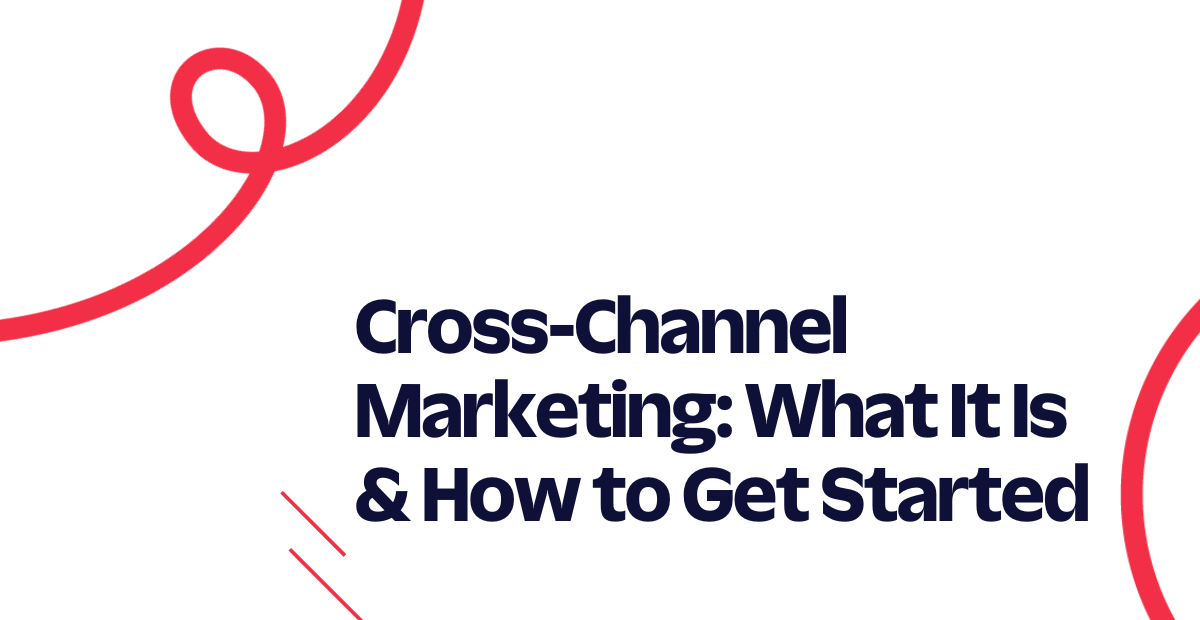Cross-Channel Marketing: What It Is & How to Get Started
Time to read: 6 minutes

Have you ever had that experience where you get a well-timed ad for something you’ve been thinking of purchasing, and within a few minutes, you’ve placed your order, and it’s on the way?
This can feel like kismet, but it’s more likely the result of a cross-channel marketing campaign.
Cross-channel marketing is a strategy businesses use to increase brand awareness and target customers throughout their journey, driving conversions and customer loyalty.
Sound like something your brand needs? Let’s dive right into what cross-channel marketing is, how it benefits businesses, and the tools you need to do it.
What is cross-channel marketing?
Cross-channel marketing refers to using multiple channels in a unified marketing campaign. These channels can include:
- Website
- Search engines
- Blog posts
- Social media
- SMS
- Print catalogs
- And more
This strategy allows you to reach new customers and nurture existing ones throughout the customer journey, using a blend of channels to keep your business top of mind and nudge them toward taking action.
Let’s illustrate this strategy with a hypothetical cross-channel marketing example:
- A customer does a Google search for “sustainable sweaters” and clicks on the first result, a search ad for a brand called Green Sweaters.
- The customer browses the brand’s website, looking at a few different sweaters.
- An email sign-up form pops up on the page, offering a discount on the customer’s first purchase if they join the Green Sweaters email list. They sign up for email and SMS communications.
- The Green Sweaters company sends the customer an introductory email and a text message with a coupon code for their first purchase.
- The customer goes into their Instagram account and, as they scroll, they see a Green Sweaters ad featuring the products they looked at on the website, plus a few similar items.
- The customer clicks on the ad and makes their first purchase, using the discount code they received earlier.
- The customer receives a catalog including a discount code and featuring the new holiday collection a few weeks later. They like the first sweater they purchased, so they page through the catalog and consider buying another one.
This is cross-channel marketing at work. In this example, the brand Green Sweaters uses search engine marketing, email marketing, SMS marketing, social media advertising, and a physical catalog to move the customer from the brand awareness stage to the purchase and retention stages of the customer journey.
How does cross-channel differ from multichannel and omnichannel?
You may have heard of these seemingly similar terms and wondered, what’s the difference? In fact, each of these describes a different communication strategy. Let’s define each one.
- Multichannel: Multichannel uses various channels to connect with customers, but each channel works independently and has unique goals. This term can apply to marketing, contact centers, and broader communication strategies.
- Omnichannel: Omnichannel also uses various channels, but the channels connect with each other and integrate with other tools like customer relationship management software. This helps businesses gather data in a centralized place and provide personalized, context-driven customer experiences. Also, like multichannel, omnichannel can apply to a range of communication strategies.
- Cross-channel: Cross-channel marketing, as defined above, uses various connected channels strategically to create brand awareness and meet customers throughout their journey. This term typically applies to marketing specifically.
How does cross-channel marketing benefit businesses?
Cross-channel marketing builds on the strengths of each channel and uses customer data to create a consistent experience. Additionally, the benefits of this type of marketing include:
Increasing brand exposure
You’ve probably heard of the marketing rule of 7, which states that a customer typically encounters a brand 7 times before deciding to engage with it.
Cross-channel marketing makes it easier to create these 7 touchpoints, especially when you use digital channels like social media and email—which can be more cost-effective and have higher return on investment (ROI) than other channels.
What makes it such a successful marketing strategy is that customers want cross-channel experiences—in Twilio Segment’s State of Personalization Report, 67% of consumers said they want to interact with brands on more than one channel.
Plus, cross-channel marketing allows you to expand your reach and capture customers who favor different channels. For example, if a customer doesn’t like to use social media, you can still reach them through search engine ads.
Boosting ROI with personalization
Data-backed cross-channel marketing campaigns help you create personalized ads, which can take the 7 encounters we just discussed to the next level.
Why is personalization so important? It’s proven to increase ROI—80% of business leaders say consumers spend more money with a personalized experience.
You can achieve this personalization by using customer data from all platforms to understand where customers are likely to engage, what types of products and services they look at, and more. This allows you to serve each customer the right experience on the right channel at the right time.
Next, we’ll discuss what tools you need to gather and activate this data.
Cross-channel marketing toolbox
Now that you understand the value of cross-channel marketing, the next question is how to get started. You’ll need a few tools to gather first-party data and deliver personalized marketing campaigns across channels. These tools include:
- Customer data platform (CDP): Gather first-party customer data, resolve customer profiles, and access real-time data across channels.
- Customer engagement platform (CEP): Activate customer data to create personalized campaigns across channels, including SMS, ads, web, and more.
- Email service platform: Send personalized email campaigns based on customer data and behavior.
- Social media advertising tools: Advertise on social media platforms like Facebook, Messenger, Instagram, TikTok, and YouTube, depending on your audience.
Tips to get started with cross-channel marketing
Follow these tips to make the most of your cross-channel marketing campaigns.
1. Resolve customer identities
With so many different customer touchpoints, you’ll need a way to track each user as they browse your website, make a purchase on mobile, click a call-to-action button in an email, etc. This is where identity resolution comes in.
Identity resolution is the process of attributing customer behaviors across channels to a single customer profile. A CDP like Segment allows you to resolve customer identities, enabling you to segment customers and personalize content more granularly for your cross-channel marketing campaigns.
2. Integrate channels
Cross-channel and omnichannel campaigns require software integrations to ensure all your channels connect and communicate. This gives you access to real-time data, allowing you to serve customers the right message on the right channel.
Most importantly, you’ll need to integrate your CDP with all the channels where you interact with customers so data flows back and forth and you can create the unified customer profiles we just discussed. Or better yet, use a CEP like Twilio Engage that combines a native CDP and omnichannel tools in one platform.
3. Use dynamic content to tailor campaigns
First-party data and channel integrations make it easier to tailor your messages to customers across channels.
For example, you can see which products a customer explored on your website, then send a personalized email that features those products and includes a discount code. Dynamic content allows you to build a standard email campaign, and it’ll automatically populate the specific products the customer viewed.
Similarly, you can personalize SMS campaigns and social media ads to show customers relevant content that’s more likely to lead to conversions.
4. Analyze and optimize
The great thing about real-time data is you can make real-time decisions about how you want to invest your campaign budget.
For example, if a certain social media ad doesn’t perform well, you can stop it and reinvest the budget into one that does. Or if customers get stuck on a certain page on your website and don’t convert, you can evaluate what the obstacle is and make the necessary adjustments.
The data from cross-channel marketing platforms enable you to continuously improve your campaigns and boost ROI.
Get started with cross-channel marketing with Twilio
Ready to give cross-channel marketing a try? Twilio has all the tools you need to create engaging campaigns across channels—whether you’re looking for a CDP or a complete CEP. You can choose from:
- Twilio Segment: Use customer data to deliver unified, personalized customer experiences with a CDP that easily integrates with your existing marketing platforms.
- Twilio Engage: Design the engagement platform your business needs and create omnichannel customer experiences from a single platform with a native CDP.
Create a free Segment account today and discover how you can deliver personalized cross-channel marketing experiences.
Related Posts
Related Resources
Twilio Docs
From APIs to SDKs to sample apps
API reference documentation, SDKs, helper libraries, quickstarts, and tutorials for your language and platform.
Resource Center
The latest ebooks, industry reports, and webinars
Learn from customer engagement experts to improve your own communication.
Ahoy
Twilio's developer community hub
Best practices, code samples, and inspiration to build communications and digital engagement experiences.


